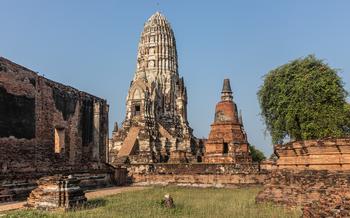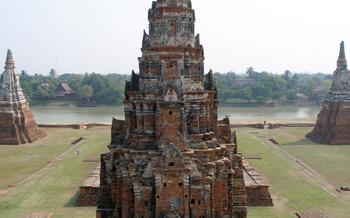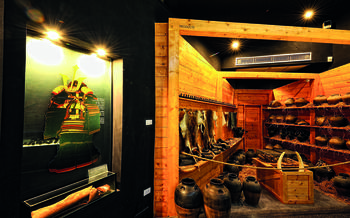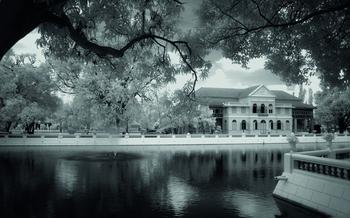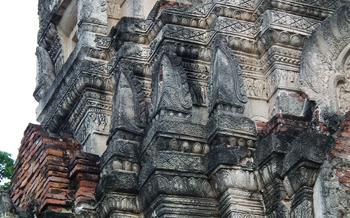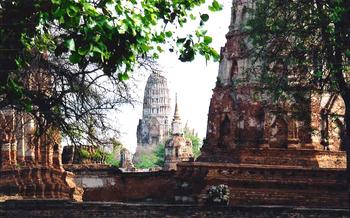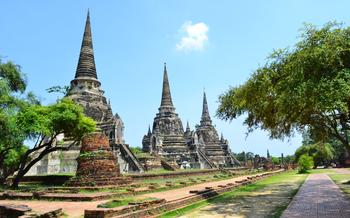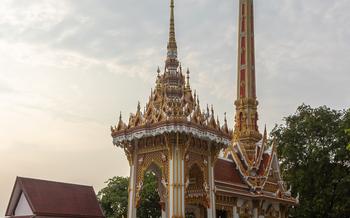
Kaeng Sapheu
- Kaeng Sapheu: A Natural Wonder
- Historical Significance
- Geological Formations
- Scenic Beauty
- Location
- Exploring the Rapids
- The Unique Ecosystem
- Cultural Significance
- Best Time to Visit
- Getting There
- Accommodation
- Food and Dining
- Other Activities
- Safety Precautions
- Photography Tips
- Budget and Costs
- Planning Your Itinerary
- Insider Tip: Hidden Gem
Kaeng Sapheu: A Natural Wonder
Historical Significance
Kaeng Sapheu holds a significant place in Thai history, serving as a strategic defense point during the Ayutthaya period. Its tumultuous rapids and intricate rock formations made it a formidable natural barrier against invading armies. Remains of ancient fortifications and military outposts can still be found in the surrounding area, offering a glimpse into the region's rich military past.
Geological Formations
The rapids of Kaeng Sapheu are a remarkable geological wonder, shaped by the relentless erosive forces of the Mun River over millions of years. The river, originating from the Dong Phaya Yen Mountains, plunges over a series of steep rock ledges, creating a spectacular cascade of churning white water. The surrounding landscape is adorned with towering limestone cliffs, jagged rock formations, and lush tropical vegetation, adding to the dramatic beauty of the site.
Scenic Beauty
Kaeng Sapheu is a visual masterpiece, captivating visitors with its stunning natural beauty. The frothing white rapids, set against the backdrop of verdant foliage and towering cliffs, create a mesmerizing spectacle. The cascading waters emit a thunderous roar, amplifying the grandeur of the surroundings. Every angle offers a unique perspective, allowing visitors to immerse themselves in the untamed beauty of this natural wonder.
Location
Kaeng Sapheu is nestled in the heart of the Ubon Ratchathani province, in northeastern Thailand. It lies approximately 60 kilometers east of the provincial capital, Ubon Ratchathani city, and can be easily reached by car or public transportation. The journey offers a glimpse into the region's picturesque countryside, passing through serene villages, rice paddies, and lush greenery.
Exploring the Rapids
Kaeng Sapheu's most thrilling feature is undoubtedly the rapids, which offer an exhilarating experience for adventure seekers. Experienced boatmen navigate these powerful currents, providing visitors with a unique perspective of the landscape and an unforgettable adrenaline rush.
The rapids vary in intensity, with some sections featuring gentle ripples and others showcasing tumultuous whitewater. As the boat navigates through the churning waters, passengers can marvel at the surrounding scenery, including towering cliffs, lush vegetation, and cascading waterfalls.
Safety is a top priority during the boat rides, and all participants are required to wear life jackets. Experienced guides provide instructions and ensure that safety protocols are followed throughout the journey.
The rapids also present fantastic photography opportunities. Capturing the raw power of the water and the excitement of the ride can create stunning images that will serve as lasting memories of this thrilling experience.
The Unique Ecosystem
Kaeng Sapheu is home to a diverse array of flora and fauna. The lush forests surrounding the rapids are teeming with a variety of tree species, including teak, rosewood, and bamboo. The area is also home to numerous species of birds, including hornbills, eagles, and kingfishers. The rapids themselves are home to a variety of fish species, including carp, catfish, and snakehead fish.
Among the most notable species found in Kaeng Sapheu is the Siamese crocodile, a critically endangered species that is endemic to Thailand. The rapids provide a vital habitat for these crocodiles, as the fast-flowing water helps to keep them cool and provides them with a safe place to nest.
The unique ecosystem of Kaeng Sapheu is also home to a variety of endemic plant species. These plants have adapted to the specific conditions of the rapids, such as the fast-flowing water and the rocky substrate. Some of the most notable endemic plant species include the Kaeng Sapheu fern and the Kaeng Sapheu orchid.
The unique ecosystem of Kaeng Sapheu is of great ecological importance. The rapids help to regulate the flow of water in the Mun River, and the forests surrounding the rapids provide a vital habitat for a variety of plant and animal species. The rapids also play an important role in the local economy, as they attract tourists from all over the world.
Conservation efforts are underway to protect the unique ecosystem of Kaeng Sapheu. The area has been designated as a national park, and a variety of measures have been put in place to protect the wildlife and the natural environment. These measures include the establishment of a ranger station, the implementation of a fire prevention program, and the development of a sustainable tourism plan.
Cultural Significance
Kaeng Sapheu holds immense cultural and spiritual value for the local communities. According to ancient legends, the rapids are believed to be the dwelling place of powerful spirits and deities. Locals pay homage to these divine beings through various rituals and ceremonies held throughout the year. One of the most significant events is the annual rocket festival, where colorful rockets are launched into the sky as offerings to the spirits, seeking blessings for good fortune and prosperity. The festival showcases the vibrant local culture and attracts visitors from near and far.
The rapids also play an essential role in the daily lives of the communities. Fishermen often cast their nets in the calm waters above the rapids, relying on the rich aquatic life for sustenance and income. The rapids serve as a natural boundary, separating and connecting different villages and towns along the river. People have learned to navigate the rapids skillfully, using traditional boats and techniques passed down through generations. Kaeng Sapheu stands as a symbol of the harmonious coexistence between nature, culture, and the lives of the local people.
Best Time to Visit
The best time to visit Kaeng Sapheu is during the dry season, which typically runs from November to April. During this time, the water levels are lower, making it easier to navigate the rapids and enjoy the stunning rock formations. The weather is also generally more pleasant, with warm and sunny days and cool nights.
While the dry season is ideal for exploring the rapids, the waterfalls are most impressive during the rainy season, which runs from May to October. During this time, the water levels are higher, and the waterfalls cascade down the cliffs with great force. However, it is important to note that the currents can be strong during the rainy season, and it is important to take necessary safety precautions.
Getting There
Reaching Kaeng Sapheu is an adventure in itself. The journey from the nearest major city, Ubon Ratchathani, takes approximately 2-3 hours by car. The route winds through picturesque countryside, passing by rice fields, small villages, and rubber plantations.
For those without their own transportation, there are several options available. Public buses depart regularly from Ubon Ratchathani and make the journey in around 3 hours. Alternatively, you can hire a private car and driver, which offers more flexibility and comfort.
The road conditions are generally good, but some sections may be narrow and winding. It's advisable to drive cautiously and be aware of local traffic regulations. If you're coming from Bangkok, the journey takes around 8-9 hours by car. It's a long drive, but the stunning scenery and the opportunity to witness rural Thai life make it a worthwhile experience.
Once you arrive at Kaeng Sapheu, there are ample parking spaces available. The entrance to the park is clearly marked, and you can easily find your way to the visitor center or the boat tour starting point.
Accommodation
When planning your stay in Ubon Ratchathani to visit Kaeng Sapheu, you'll find a range of accommodation options to suit different preferences and budgets. Here's a closer look:
- Hotels and Resorts:
-
For a comfortable and convenient stay, consider nearby hotels or resorts. These establishments offer a variety of amenities, including swimming pools, fitness centers, and restaurants.
-
Homestays and Guesthouses:
-
For a more immersive experience, opt for a homestay or guesthouse. These accommodations provide a chance to interact with local families and gain insights into their culture and way of life.
-
Camping Facilities:
-
If you prefer to be closer to nature, camping is an excellent option. Designated campsites are available in the area, allowing you to enjoy the serene surroundings and the tranquility of the rapids.
-
Amenities and Services:
- No matter your choice of accommodation, you'll find that most options offer essential amenities such as Wi-Fi, air conditioning, and private bathrooms. Some accommodations also provide tour arrangements and other services to enhance your stay.
Food and Dining
When visiting Kaeng Sapheu, you will be delighted by the local cuisine that reflects the rich culinary heritage of Ubon Ratchathani. Indulge in mouthwatering dishes that are infused with fresh regional ingredients, spices, and herbs. From savory noodle soups to grilled meats and vibrant salads, there's something to satisfy every palate.
For an authentic dining experience, head to the local markets or street food stalls. Here, you'll find an array of delectable delicacies, including spicy papaya salad, grilled chicken with sticky rice, and the iconic boat noodles. Sample fresh tropical fruits, including mangoes, pineapples, and rambutans, which are grown locally and bursting with flavor.
If you prefer a more formal dining experience, there are several restaurants in the area that offer a range of cuisines. From traditional Thai dishes to international fare, you'll find options to suit your taste and budget. Whether you're craving a hearty breakfast, a leisurely lunch, or a romantic dinner, the culinary scene at Kaeng Sapheu will not disappoint.
And if you're looking for a unique and memorable dining experience, why not pack a picnic and find a secluded spot along the riverbanks? Enjoy a leisurely meal surrounded by the stunning natural scenery, with the sound of the rapids providing a tranquil backdrop. Just remember to dispose of your waste responsibly to help preserve the pristine environment.
Other Activities
In addition to exploring the rapids, Kaeng Sapheu offers a range of other activities for visitors to enjoy. Hiking enthusiasts will delight in the scenic trails that wind through the surrounding forests, providing opportunities for exploration and wildlife spotting. Keep an eye out for monkeys, gibbons, and a variety of bird species that call this area home.
Anglers can cast their lines in the river, hoping to hook a variety of fish species, including catfish, carp, and tilapia. For those who prefer a more relaxed experience, there are several picnic spots along the riverbanks, where you can enjoy a leisurely meal while soaking up the natural beauty of the surroundings.
History buffs may also want to visit the nearby Ban Kham Yai National Museum, which houses a collection of artifacts and exhibits that shed light on the local history and culture.
Safety Precautions
Visiting Kaeng Sapheu is generally safe, but certain precautions should be taken to ensure a smooth and enjoyable experience.
- Water Safety Guidelines: The currents and rapids can be strong, making swimming or wading dangerous. Always wear a life jacket when participating in water activities.
- Respecting the Environment: Avoid littering or damaging the natural surroundings. Refrain from disturbing wildlife and respect their habitats.
- Avoiding Dangerous Areas: Stay away from unmarked trails or restricted zones. Be mindful of slippery rocks and uneven surfaces.
- Emergency Contacts: Keep emergency contact numbers handy, including local authorities and medical services. Inform your accommodation or tour operator of your planned activities.
Photography Tips
Kaeng Sapheu presents a plethora of photographic opportunities, from the mesmerizing rapids to the serene landscapes. To capture the essence of this natural wonder, consider the following tips:
- Capturing the Rapids:
- Use a fast shutter speed to freeze the motion of the water, creating a sense of dynamism and energy.
- Experiment with different angles to convey the scale and power of the rapids.
-
Include elements such as rocks, trees, or boats to provide context and depth to your shots.
-
Scenic Landscapes:
- Take advantage of the golden hour, just after sunrise or before sunset, to capture the warm, diffused light that beautifully illuminates the surroundings.
- Utilize a wide-angle lens to encompass the vastness of the landscape, including the lush greenery, towering cliffs, and meandering river.
-
Incorporate leading lines, such as a path or a riverbank, to draw the viewer's eye into the image.
-
Wildlife Photography:
- Be patient and observant to spot wildlife, such as birds, monkeys, or reptiles, in their natural habitat.
- Use a telephoto lens to capture close-up shots while maintaining a respectful distance from the animals.
-
Consider using a tripod for stability, especially when shooting in low-light conditions.
-
Best Lighting Conditions:
- The early morning and late afternoon hours offer the most favorable lighting conditions, as the sun's rays cast a warm, golden glow on the landscape.
- Overcast days can also be ideal for photography, as the diffused light reduces harsh shadows and creates a softer, more even illumination.
Budget and Costs
Visiting Kaeng Sapheu and experiencing its natural wonders comes with associated costs. Here's a breakdown of the expenses you may encounter:
-
Entrance Fees: There's no entrance fee to access Kaeng Sapheu National Park, allowing you to enjoy the stunning scenery without any upfront charges.
-
Boat Tour Prices: Embarking on a thrilling boat ride through the rapids is a must-do experience. Boat tour prices vary depending on the duration and group size, typically ranging from 300 to 500 THB per person.
-
Accommodation Rates: If you're planning an overnight stay near Kaeng Sapheu, there are various accommodation options available. Guesthouses and homestays offer budget-friendly choices, with rates starting around 300 THB per night. For a more comfortable experience, mid-range hotels and resorts offer rooms starting from 1,000 THB per night.
-
Food and Beverage Expenses: Local cuisine is affordable and widely available in the area. You can indulge in delicious meals at local restaurants for around 100-200 THB per person. Street food options are even more economical, with snacks and drinks costing as little as 20-50 THB.
-
Additional Costs: Remember to budget for additional expenses such as transportation to and from Kaeng Sapheu, which can vary depending on your chosen mode of transport. If you're planning to go fishing, you may need to rent equipment, which can cost around 100-200 THB per day.
Planning Your Itinerary
When planning your visit to Kaeng Sapheu, it's essential to allocate sufficient time to fully immerse yourself in its natural wonders and cultural significance. Depending on your interests and budget, you can easily spend a few days exploring the area. Consider combining your trip to Kaeng Sapheu with visits to other nearby destinations such as Pha Taem National Park, known for its stunning rock formations, or the vibrant city of Ubon Ratchathani, offering a glimpse into local life and history. To make the most of your time, create a customized schedule that aligns with your preferences, allowing ample time for exploring the rapids, hiking trails, and nearby attractions. Don't forget to pack essential items such as comfortable shoes, swimwear, insect repellent, and a camera to capture the breathtaking scenery.
Insider Tip: Hidden Gem
Beyond the main attractions, Kaeng Sapheu offers hidden gems waiting to be discovered. Venture off the beaten path and explore the lesser-known corners of this natural wonder. Ask locals for their recommendations and they might point you towards secluded viewpoints with breathtaking panoramas, serene spots for a peaceful picnic, or secret trails that lead to hidden waterfalls. With a little exploration, you'll uncover the true magic of Kaeng Sapheu and create memories that will last a lifetime.

